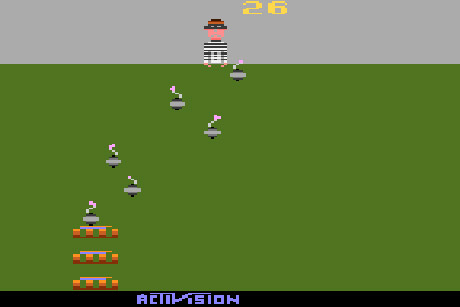The difference between narrative, and play (Or play + rules)
By just_nonplussed 11 Comments
In response to an on-going dialogue between myself and others on this site, on the way video games tell stories, this blog will attempt to come to some kind of a conclusion on some contested points. These points of contention revolve around the meaning of the term narrative, or story. To avoid falling into an abyss (Although that sounds like terrific fun), I will be using the Atari 2600 game, Kaboom! to illustrate my point clearly and to keep 'on topic'.

Kaboom! is a single-screen arcade-type game from the 80s. You move a 'bucket' (A single bucket that contains 3 segments, or sub-buckets) that acts in the same way as a paddle from Breakout or Pong (You can only move left and right). So you are represented in the game space by the bucket. I'm using the term bucket loosely, because it's simpler than saying bomb diffuser. So here comes the story. There's a 'mad bomber' and he is intent on bombing 'stuff' up; he also appears to be convict/terrorist. Not much more official information is given, except that your role within the game space is to diffuse his bombs and stop the threat. The way Kaboom! is balanced though makes this plot almost unresolvable/impossible. This is because the better you are at your job, as this bomb diffusion expert, the faster the bomber gets (You could say he becomes more violent, more efficient, or more eratic). There are other nuances, in the gameplay, but they can't be said to significantly affect the drama or conclusion of the story. You just can't win. Interestingly In 2011, it's a topical game to fire up...But let's move on now to discussing rules & play, and then I will make some comparissons.
The rules are strict in Kaboom!. It's a very tightly balanced game, and unique in its design. Usually the player has a way of fighting back (A laser for example, as in Space Invaders, or most any other game) even if the odds are stacked against them, but in Kaboom! you have no method of force; your every move is controlled by patterns of bombs as they flow down the screen until you enter a kind of hypnotic daze. In my experience, I think it's the video game that puts the player in the weakest possible position with barely any choice for deviation. Most games are about being a super soldier where you have god-like powers and abilities, but Kaboom! is about submission and domination. This isn't just a story, it's a relationship between the game and the player. You yourself are being controlled, hypnotized and dominated whether this process is fun or not fun.
In the above two paragraphs I've clearly made distinctions between the story (Inclusive of gameplay and the player) and then I've isolated just the rules & play. However, in my view there are two different stories going on here. There is the story of the game creator who has put these rules; these bindings, on your consciousness through the act of play, and then there is the Mad Bomber Vs. the bomb diffuser. The former is an agreement or relationship between two people via a computer system. The latter is an interactive narrative. But I contest that the former is also a valid narrative. It is valid because it shapes consciousness, has an emotional effect and leaves a memory in the mind of the player. Of course, the Mad bomber Vs. the bomb diffuser story (Inclusive of the involvement of the player as a character in the story) may also leave a memory and an emotional response, but it would be in the context of the explicit narrative (i.e What the back of the box says and what the relation of graphical images say).
I personally think that there is no room in the Mad Bomber Vs. the bomb diffuser story for submissive consciousness and brutal domination. These ideas and feelings arise in me due to the constraints of the system on my mind, not as the result of the explicit, 'official' narrative. Furthermore, If Kaboom! were to be made in 2011 without the awareness of the 80s version of Kaboom!, it would not be balanced like it is and would most probably be something that tries to be realistic like Kayne & Lynch or Medal of Honor. I haven't played either of those games but I can bet they have resolutions to their respective narratives, and I can bet they are not about being submissive or controlled (Either in a gameplay sense or in a story premise/pretext sense).
I hope this blog has established and shed light on the contention points (And attempted to resolve them) in the dialogue I was having with various people on the site through thread posts. :-) And I also hope it brings others into the discussion who haven't thought about this much before.
As an interesting point to finish on, in order to turn the 'implicit narrative' into the 'explicit narrative', could you imagine the current symbols changing to represent this? Lol.
Actually, I don't like the term 'implicit/explicit' because it suggests a rivalry (In which the implicit is subordinate). The story between game designer and game player is real, in spite of/because of/in parallel to the video game narrative that is presented to you at face value.
EDIT: As an observation though, in order for there not to be this 'narrative split' in Kaboom, I think the game should not get faster. The Mad Bomber should just destroy you and the game would end rather quickly. You could argue that the story is 'abstract' but I don't think it was intended to be so.
--
based on previous discussion:
storytelling in video games
more narrative-centric games
